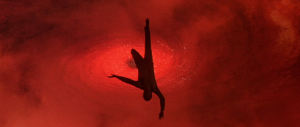Sci-Fi went through a major transformation in the late 1960s, from the camp (e.g., Robinson Crusoe on Mars) to the distopian, beginning with 1968’s Planet of the Apes. This distopian phase lasted until 1977 with the release of Star Wars, which caught everyone by surprise, and the studios scrambled to come up with their own space adventure films. Disney’s response was The Black Hole, a dark, plodding horror film. Yes, I mean horror–the villain in the film (spoilers!) turns his crew into robot zombies! And one of the heroes dies perhaps the most gruesome death I’ve seen in a PG-rated movie. It’s extraordinary that Disney’s takeaway points from Star Wars seem to be limited to “Set it in space,” and “Include wise-cracking robots.” “Nothing appeals to the kids more than an Ernest Borgnine movie,” they thought to themselves.
On to the movie: we’re going to ignore the “weightlessness” scenes in which you can see the wires. At least they tried. Although with almost twice the budget of Star Wars, maybe they could’ve tried a little harder.
The heroes discover a ship called the Cygnus, thought to be lost, hovering perilously close to a black hole. When moving in closer to check it out, they get caught by the gravitational pull. Their ship is damaged, so the humans send R2… sorry… V.I.N.CENT. out to perform some repairs, using magnets to stick to the hull of the ship. (Clearly Lucas remembered this scene when he made the regrettable prequels.) We’re off to a good start, until the heroine, Dr. Kate McCrae, uses E.S.P. to communicate with the robot. Really, film? E.S.P? He’s a robot. If only they had some means of electronic communication onboard.
Once they regain control of their ship, the heroes discover that the Cygnus isn’t abandoned, as they previously thought–someone is there, watching them. Couldn’t “Dr.” Kate have sensed this with her E.S.P? And what’s her doctorate in anyway? Pseudo-science? Regardless, the Cygnus is generating a zero-gravity field that allows it to remain safely right on the edge of the black hole’s event horizon. The ship also has artificial gravity. So it’s somehow defying the gravitational attraction of the black hole while simultaneously generating its own Earth-like gravity. That seems like a LOT of work.
The evil scientist villain plans to take the Cygnus through the black hole. “But wait,” I hear you saying. “Isn’t that impossible?” Well…maybe. There are some solutions in general relativity that allow for the existence of wormholes, with the “mouth” at each end being a black hole. In the film, they use the sci-fi trope of an Einstein-Rosen bridge, which isn’t the preferable model for a traversable wormhole, but the leading theories for the traversable variety weren’t published until a decade or so after this film came out, so you can’t fault them there. The actual depiction of the black hole in the film isn’t terrible, though one wonders how a (presumably) stellar mass black hole has an accretion disk with no obvious star(s) nearby for fuel.

As I said, in my commentary on Supernova, you can get away with a lot in sci-fi if you don’t explain it or use too much technobabble, so I can forgive this film the artificial gravity on the Cygnus and the anti-gravity technology that keeps it safe right next to a black hole. That’s just stuff we haven’t figured out yet. What I can’t forgive is the final act of the film, which includes a swarm of glowing, fiery meteorites smashing up the Cygnus on their way into the black hole. One of the fireballs comes rolling down the central corridor of the ship, Raiders of the Lost Ark-style, and the heroes narrowly escape. Of course, the explosive decompression from having a huge hole punched in the ship by the meteor would have blown them into the vacuum of space where they would’ve died horribly. Actually, given some of the other deaths suffered in the film, that might be the preferable way to go…
Later, another meteorite grazes the ship and there is some decompression, though it’s much slower than you’d expect. Turns out exposure to space just makes things instantly cold. Who knew? With the Cygnus now full of holes, our heroes rush towards an escape ship. The artificial gravity is clearly failing, because if they jump or trip, they float off into space. As in space. Through one of the holes in the ship. The cold and lack of air don’t seem to be problems anymore.

The film concludes with the surviving heroes successfully traversing the black hole, the villain literally going to hell, and Disney marketing this thing to children.

knee-deep in electric slime
You’ll suffer ’till the end of time
enduring tortures, most of which rhyme
Trapped forever here in Robot Hell!



